Raman and FT-IR Spectroscopy Coupled with Machine Learning for the Discrimination of Different Vegetable Crop Seed Varieties
Abstract
1. Introduction
2. Results
2.1. Raman Spectroscopy Seed Fingerprinting
2.2. FT-IR Spectroscopy Seed Fingerprinting
2.3. Chemometric Analysis of the Raman and FT-IR Spectra of Lettuce, Paprika, and Tomato Varieties
2.4. Merging Raman and FT-IR Spectral Information
3. Discussion
4. Materials and Methods
4.1. Seed Material
4.2. FT-IR Spectroscopymeasurements
4.3. Raman Spectroscopy Acquisition
4.4. Chemometric Analysis
4.5. Preprocessing
5. Conclusions
Author Contributions
Funding
Data Availability Statement
Acknowledgments
Conflicts of Interest
References
- Bogdanović, S.; Mladenov, V.; Balešević-Tubić, S. The importance of using certified seed. Sel. i Semen. 2015, 21, 63–67. [Google Scholar] [CrossRef]
- Kelly, A.F. Seed Production of Agricultural Crops; Wiley: Harlow, UK, 2013. [Google Scholar]
- UPOV-International Convention for the Protection of New Varieties of Plants; International Union for the Protection of New Varieties of Plants: Geneva, Switzerland, 1988.
- Bora, A.; Choudhury, P.R.; Pande, V.; Mandal, A.B. Assessment of genetic purity in rice (Oryza sativa L.) hybrids using microsatellite markers. 3 Biotech 2016, 6, 50. [Google Scholar] [CrossRef]
- Smith, J.S.C.; Register, J.C., III. Genetic purity and testing technologies for seed quality: A company perspective. Seed Sci. Res. 1998, 8, 285–294. [Google Scholar] [CrossRef]
- ISTA. ISTA Handbook of Variety Testing—Electrophoresis Handbook: Variety Identification; Cooke, R., Ed.; International Seed Testing Association: Zurich, Switzerland, 1992. [Google Scholar]
- Pattanaik, A.; Lakshmana Reddy, D.C.; Ramesh, S.; Chennareddy, A. Comparison of Traditional Grow-Out Test and DNA-Based PCR Assay to Estimate F1 Hybrid Purity in Cauliflower. Curr. Sci. 2018, 115, 2095. [Google Scholar] [CrossRef]
- Zhao, T.; Yan, M.; Lu, Y.P.; Yang, F.; Huang, J.; Wang, X.F. Genetic purity testing of two-line hybrid rice seeds by ultrathin-layer isoelectric focusing of proteins. Seed Sci. Technol. 2005, 33, 45–52. [Google Scholar] [CrossRef]
- Dou, X.Y.; Yan, M.; Xu, Y.F.; Hussain, K.; Liu, Y.Z.; Lin, F. Identification and purity testing of maize hybrids with one parent in common by ultrathin-layer isoelectric focusing of seed salt-soluble proteins. Turk. J. Agric. For. 2012, 36, 267–273. [Google Scholar] [CrossRef]
- Yan, M. Application of ultrathin-layer isoelectric focusing for genetic purity testing of F1 hybrid seeds in napa cabbage. Seed Sci. Technol. 2013, 41, 148–153. [Google Scholar] [CrossRef]
- Liu, L.; Liu, G.; Gong, Y.; Dai, W.; Wang, Y.; Yu, F.; Ren, Y. Evaluation of Genetic Purity of F1 Hybrid Seeds in Cabbage with RAPD, ISSR, SRAP, and SSR Markers. HortScience 2007, 42, 724–727. [Google Scholar] [CrossRef]
- Yu, H.F.; Wang, J.S.; Zhao, Z.Q.; Sheng, X.G.; Gu, H.H. DNA fingerprinting and genetic purity testing of a new broccoli hybrid using SSR markers. Seed Sci. Technol. 2013, 41, 464–468. [Google Scholar] [CrossRef]
- Chen, L.; Xu, H.; Song, B.; Zhang, H.; Kuang, Y.; Youan, X. Identification of Genetic Purity of Bitter Gourd Hybrid by ISSR Markers. Agric. Sci. Technol. 2015, 16, 649–652. [Google Scholar]
- Jadhav, V.; Vermla, O. Assessment of genetic purity in hybrid lines by field grow-out test and molecular markers. Asian J. Biol. Sci. 2016, 11, 106–118. [Google Scholar] [CrossRef]
- Kumar, S.P.J.; Susmita, C.; Agarwal, D.K.; Pal, G.; Rai, A.K.; Simal-Gandara, J. Assessment of Genetic Purity in Rice Using Polymorphic SSR Markers. 27 August 2020. Available online: https://www.researchsquare.com/article/rs-64355/v1 (accessed on 15 January 2024).
- Qiu, G.; Lü, E.; Wang, N.; Lu, H.; Wang, F.; Zeng, F. Cultivar Classification of Single Sweet Corn Seed Using Fourier Transform Near-Infrared Spectroscopy Combined with Discriminant Analysis. Appl. Sci. 2019, 9, 1530. [Google Scholar] [CrossRef]
- Amir, R.M.; Anjum, F.M.; Khan, M.I.; Khan, M.R.; Pasha, I.; Nadeem, M. Application of Fourier transform infrared (FTIR) spectroscopy for the identification of wheat varieties. J. Food Sci. Technol. 2013, 50, 1018–1023. [Google Scholar] [CrossRef] [PubMed]
- Seregély, Z.; Deák, T.; Bisztray, G.D. Distinguishing melon genotypes using NIR spectroscopy. Chemom. Intell. Lab. Syst. 2004, 72, 195–203. [Google Scholar] [CrossRef]
- Farber, C.; Sanchez, L.; Rizevsky, S.; Ermolenkov, A.; McCutchen, B.; Cason, J.; Simpson, C.; Burow, M.; Kurouski, D. Raman Spectroscopy Enables Non-Invasive Identification of Peanut Genotypes and Value-Added Traits. Sci. Rep. 2020, 10, 7730. [Google Scholar] [CrossRef]
- da Mata, M.M.; Rocha, P.D.; de Farias, I.K.; da Silva, J.L.; Medeiros, E.P.; Silva, C.S.; da Silva Simões, S. Distinguishing cotton seed genotypes by means of vibrational spectroscopic methods (NIR and Raman) and chemometrics. Spectrochim. Acta Part A Mol. Biomol. Spectrosc. 2022, 266, 120399. [Google Scholar] [CrossRef]
- Lamanna, R.; Cattivelli, L.; Miglietta, M.L.; Troccoli, A. Geographical origin of durum wheat studied by 1 H-NMR profiling. Magn. Reson. Chem. 2011, 49, 1–5. [Google Scholar] [CrossRef]
- Kim, S.-Y.; Kim, E.; Shin, B.K.; Seo, J.-A.; Kim, Y.-S.; Lee, D.Y.; Choi, H.-K. NMR-based metabolic profiling discriminates the geographical origin of raw sesame seeds. Food Control 2020, 112, 107113. [Google Scholar] [CrossRef]
- Zhou, Y.; Kim, S.-Y.; Lee, J.-S.; Shin, B.-K.; Seo, J.-A.; Kim, Y.-S.; Lee, D.-Y.; Choi, H.-K. Discrimination of the Geographical Origin of Soybeans Using NMR-Based Metabolomics. Foods 2021, 10, 435. [Google Scholar] [CrossRef]
- Brigante, F.I.; García, M.E.; López Radcenco, A.; Moyna, G.; Wunderlin, D.A.; Baroni, M.V. Identification of chia, flax and sesame seeds authenticity markers by NMR-based untargeted metabolomics and their validation in bakery products containing them. Food Chem. 2022, 387, 132925. [Google Scholar] [CrossRef]
- Jeon, H.; Lee, S.C.; Cho, Y.J.; Oh, J.H.; Kwon, K.; Kim, B.H. A triple-isotope approach for discriminating the geographic origin of Asian sesame oils. Food Chem. 2015, 167, 363–369. [Google Scholar] [CrossRef]
- Charoensumran, P.; Rauytanapanit, M.; Sricharoen, N.; Smith, B.L.; Wongravee, K.; Maher, S.; Praneenararat, T. Rapid geographical indication of peppercorn seeds using corona discharge mass spectrometry. Sci. Rep. 2021, 11, 16089. [Google Scholar] [CrossRef]
- Hashimoto, K.; Badarla, V.R.; Kawai, A.; Ideguchi, T. Complementary vibrational spectroscopy. Nat. Commun. 2019, 10, 4411. [Google Scholar] [CrossRef]
- Larkin, P. Infrared and Raman Spectroscopy—Principles and Spectral Interpretation; Elsevier Ltd.: Amsterdam, The Netherlands, 2011. [Google Scholar]
- Seidler-Lozykowska, K.; Baranska, M.; Baranski, R.; Krol, D. Raman Analysis of Caraway (Carum carvi L.) Single Fruits. Evaluation of Essential Oil Content and Its Composition. J. Agric. Food Chem. 2010, 58, 5271–5275. [Google Scholar] [CrossRef] [PubMed]
- Edmonds, J.M. Seed coat structure and development in Solanum L. section Solanum (Solanaceae). Bot. J. Linn. Soc. 1983, 87, 229–246. [Google Scholar] [CrossRef]
- Szymańska-Chargot, M.; Chylińska, M.; Pieczywek, P.M.; Rösch, P.; Schmitt, M.; Popp, J.; Zdunek, A. Raman imaging of changes in the polysaccharides distribution in the cell wall during apple fruit development and senescence. Planta 2016, 243, 935–945. [Google Scholar] [CrossRef] [PubMed]
- Baranski, R.; Baranska, M.; Schulz, H.; Simon, P.W.; Nothnagel, T. Single seed Raman measurements allow taxonomical discrimination of Apiaceae accessions collected in gene banks. Biopolymers 2006, 81, 497–505. [Google Scholar] [CrossRef]
- Chylińska, M.; Szymańska-Chargot, M.; Zdunek, A. Imaging of polysaccharides in the tomato cell wall with Raman microspectroscopy. Plant Methods 2014, 10, 14. [Google Scholar] [CrossRef]
- Synytsya, A. Fourier transform Raman and infrared spectroscopy of pectins. Carbohydr. Polym. 2003, 54, 97–106. [Google Scholar] [CrossRef]
- Kennedy, J.A.; Troup, G.J.; Pilbrow, J.R.; Hutton, D.R.; Hewitt, D.; Hunter, C.R.; Ristic, R.; Iland, P.G.; Jones, G.P. Development of seed polyphenols in berries from Vitis vinifera L. cv. Shiraz. Aust. J. Grape Wine Res. 2000, 6, 244–254. [Google Scholar] [CrossRef]
- Schulz, H.; Baranska, M. Identification and quantification of valuable plant substances by IR and Raman spectroscopy. Vib. Spectrosc. 2007, 43, 13–25. [Google Scholar] [CrossRef]
- Caires, A.R.L.; Teixeira, M.R.O.; Súarez, Y.R.; Andrade, L.H.C.; Lima, S.M. Discrimination of Transgenic and Conventional Soybean Seeds by Fourier Transform Infrared Photoacoustic Spectroscopy. Appl. Spectrosc. 2008, 62, 1044–1047. [Google Scholar] [CrossRef] [PubMed]
- Schwanninger, M.; Rodrigues, J.C.; Fackler, K. A Review of Band Assignments in near Infrared Spectra of Wood and Wood Components. J. Near Infrared Spectrosc. 2011, 19, 287–308. [Google Scholar] [CrossRef]
- Smolikova, G.N.; Laman, N.A.; Boriskevich, O.V. Role of chlorophylls and carotenoids in seed tolerance to abiotic stressors. Russ. J. Plant Physiol. 2011, 58, 965–973. [Google Scholar] [CrossRef]
- Alcantara, G.B.; Barison, A.; da Silva Santos, M.; Santos, L.P.S.; de Toledo, F.F.J.; Gilberto Ferreira, A. Assessment of genetically modified soybean crops and different cultivars by Furier transform infrared spectroscopy and chemometric analysis. Electron. J. Chem. 2010, 2, 41–52. [Google Scholar]
- Boyaci, I.H.; Temiz, H.T.; Geniş, H.E.; Soykut, E.A.; Yazgan, N.N.; Güven, B.; Uysal, R.S.; Bozkurt, A.G.; İlaslan, K.; Torun, O.; et al. Dispersive and FT-Raman spectroscopic methods in food analysis. RSC Adv. 2015, 5, 56606–56624. [Google Scholar] [CrossRef]
- Goldberg, Y.; Elhadad, M. splitSVM: Fast, space-efficient, non-heuristic, polynomial kernel computation for NLP applications. In Proceedings of ACL-08: HLT, Short Papers; Association for Computational Linguistics: Columbus, OH, USA, 2008; pp. 237–240. [Google Scholar]
- Dijkstra, A.G.; Jansen, T.L.C.; Knoester, J. Two-Dimensional Spectroscopy of Extended Molecular Systems: Applications to Energy Transport and Relaxation in an α-Helix. J. Phys. Chem. A 2010, 114, 7315–7320. [Google Scholar] [CrossRef]
- Alonso-Simón, A.; García-Angulo, P.; Mélida, H.; Encina, A.; Álvarez, J.M.; Acebes, J.L. The use of FTIR spectroscopy to monitor modifications in plant cell wall architecture caused by cellulose biosynthesis inhibitors. Plant Signal Behav. 2011, 6, 1104–1110. [Google Scholar] [CrossRef]
- Martini, W.; Porto, B.; de Oliveira, M.; Sant’Ana, A. Comparative Study of the Lipid Profiles of Oils from Kernels of Peanut, Babassu, Coconut, Castor and Grape by GC-FID and Raman Spectroscopy. J. Braz. Chem. Soc. 2017, 29, 390–397. [Google Scholar] [CrossRef]
- Su, W.; Sun, D. Fourier Transform Infrared and Raman and Hyperspectral Imaging Techniques for Quality Determinations of Powdery Foods: A Review. Compr. Rev. Food Sci. Food Saf. 2018, 17, 104–122. [Google Scholar] [CrossRef] [PubMed]
- Pandiselvam, R.; Sruthi, N.U.; Kumar, A.; Kothakota, A.; Thirumdas, R.; Ramesh, S.V.; Cozzolino, D. Recent Applications of Vibrational Spectroscopic Techniques in the Grain Industry. Food Rev. Int. 2023, 39, 209–239. [Google Scholar] [CrossRef]
- Boser, B.E.; Guyon, I.M.; Vapnik, V.N. A training algorithm for optimal margin classifiers. In Proceedings of the Fifth Annual Workshop on Computational Learning Theory, Pittsburgh, PA, USA, 27–29 July 1992; ACM: New York, NY, USA, 1992; pp. 144–152. [Google Scholar]
- Noble, W.S. What is a support vector machine? Nat. Biotechnol. 2006, 24, 1565–1567. [Google Scholar] [CrossRef] [PubMed]
- Ben-Hur, A.; Ong, C.S.; Sonnenburg, S.; Schölkopf, B.; Rätsch, G. Support Vector Machines and Kernels for Computational Biology. PLoS Comput. Biol. 2008, 4, e1000173. [Google Scholar] [CrossRef]
- Sun, J.; Jiang, S.; Mao, H.; Wu, X.; Li, Q. Classification of Black Beans Using Visible and Near Infrared Hyperspectral Imaging. Int. J. Food Prop. 2016, 19, 1687–1695. [Google Scholar] [CrossRef]
- Siqueira, L.F.S.; Araújo Júnior, R.F.; de Araújo, A.A.; Morais, C.L.M.; Lima, K.M.G. LDA vs. QDA for FT-MIR prostate cancer tissue classification. Chemom. Intell. Lab. Syst. 2017, 162, 123–129. [Google Scholar] [CrossRef]
- Ryabchykov, O.; Guo, S.; Bocklitz, T. Analyzing Raman spectroscopic data. Phys. Sci. Rev. 2019, 4, 20170043. [Google Scholar] [CrossRef]
- Guo, S.; Bocklitz, T.; Popp, J. Optimization of Raman-spectrum baseline correction in biological application. Analyst 2016, 141, 2396–2404. [Google Scholar] [CrossRef]
- Barnes, R.J.; Dhanoa, M.S.; Lister, S.J. Standard Normal Variate Transformation and De-Trending of Near-Infrared Diffuse Reflectance Spectra. Appl. Spectrosc. 1989, 43, 772–777. [Google Scholar] [CrossRef]
- Otto, M. Chemometrics: Statistics and Computer Application in Analytical Chemistry, 3rd ed.; Wiley: New York, NY, USA, 2016. [Google Scholar]
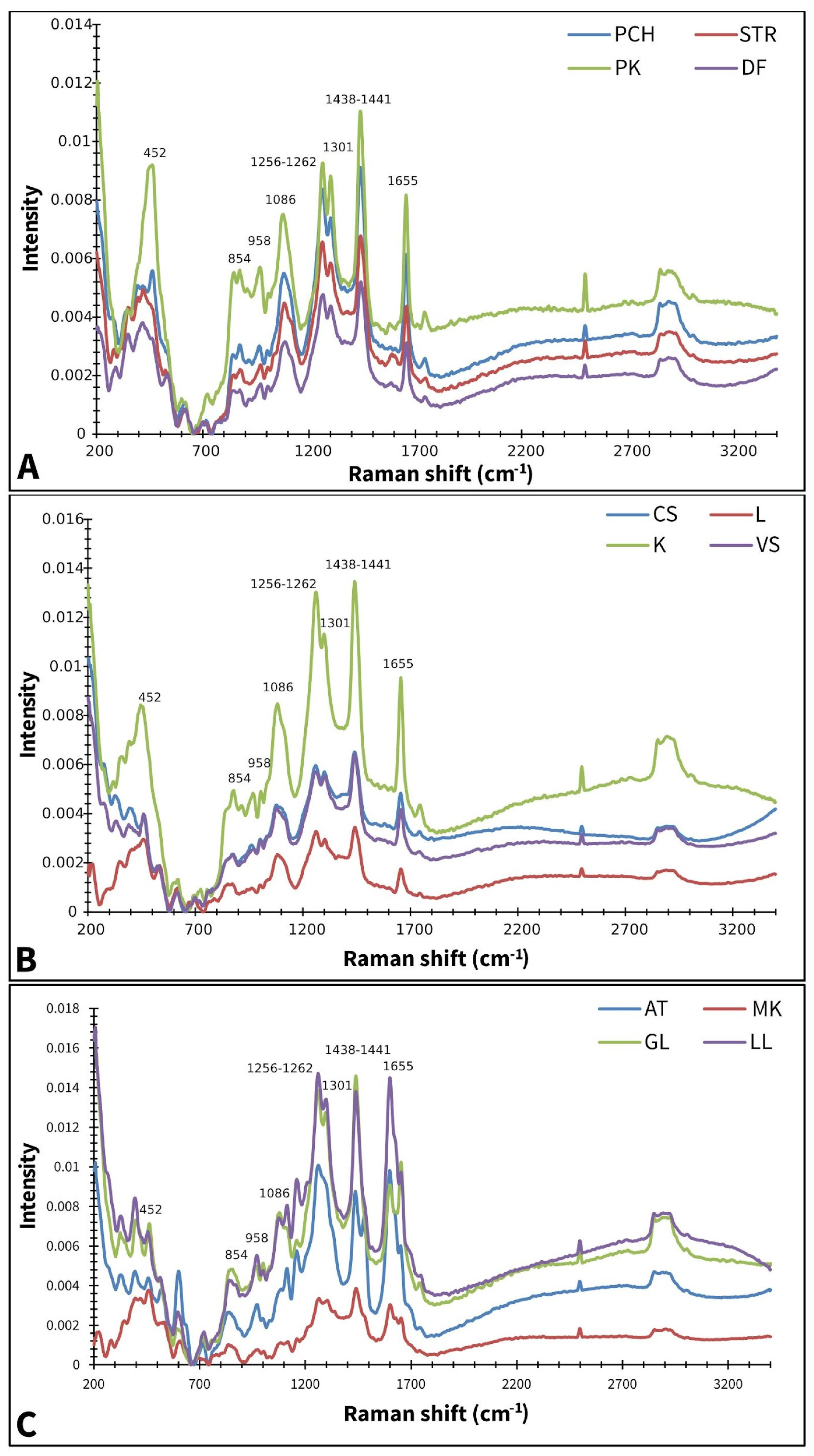


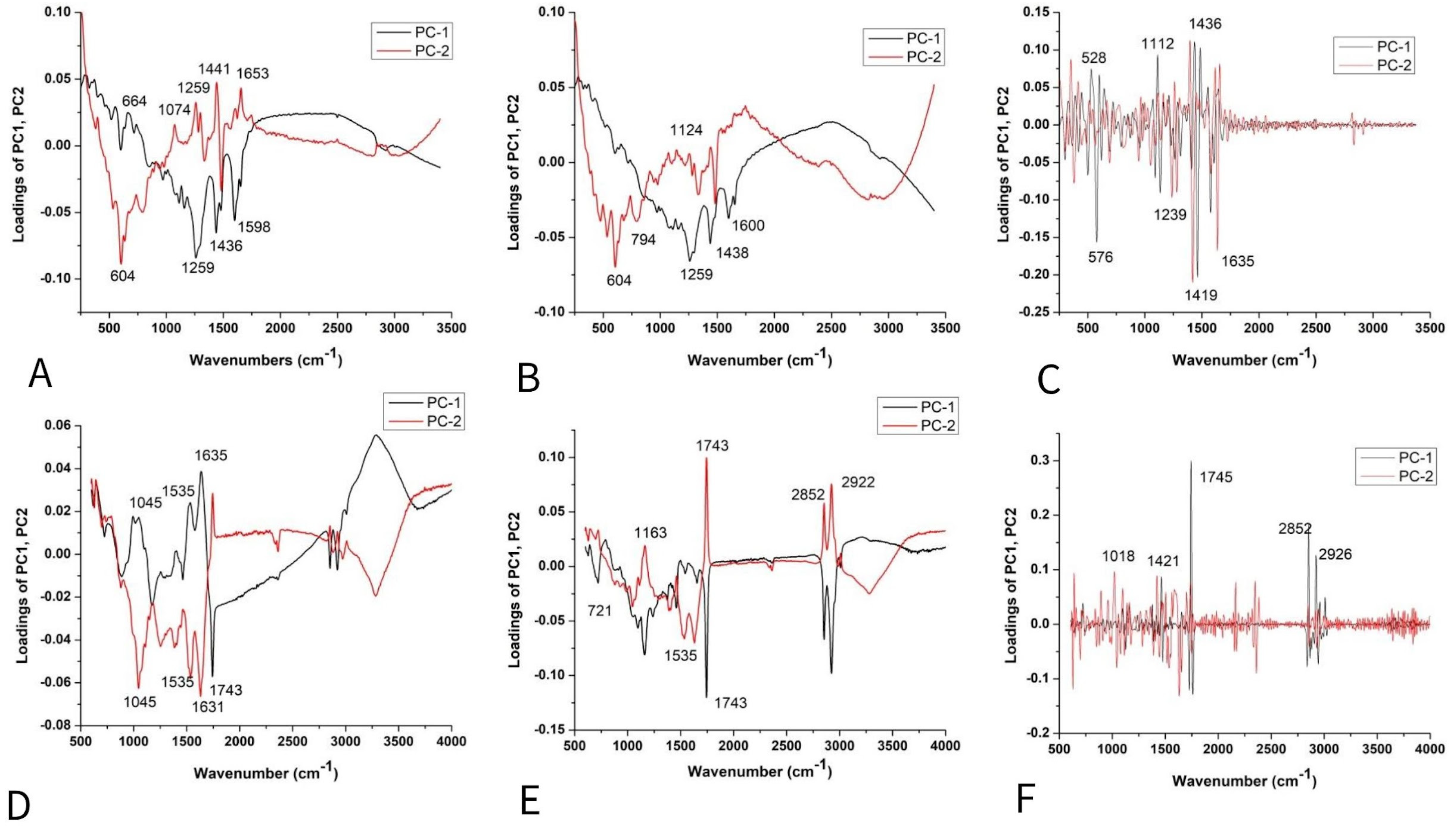


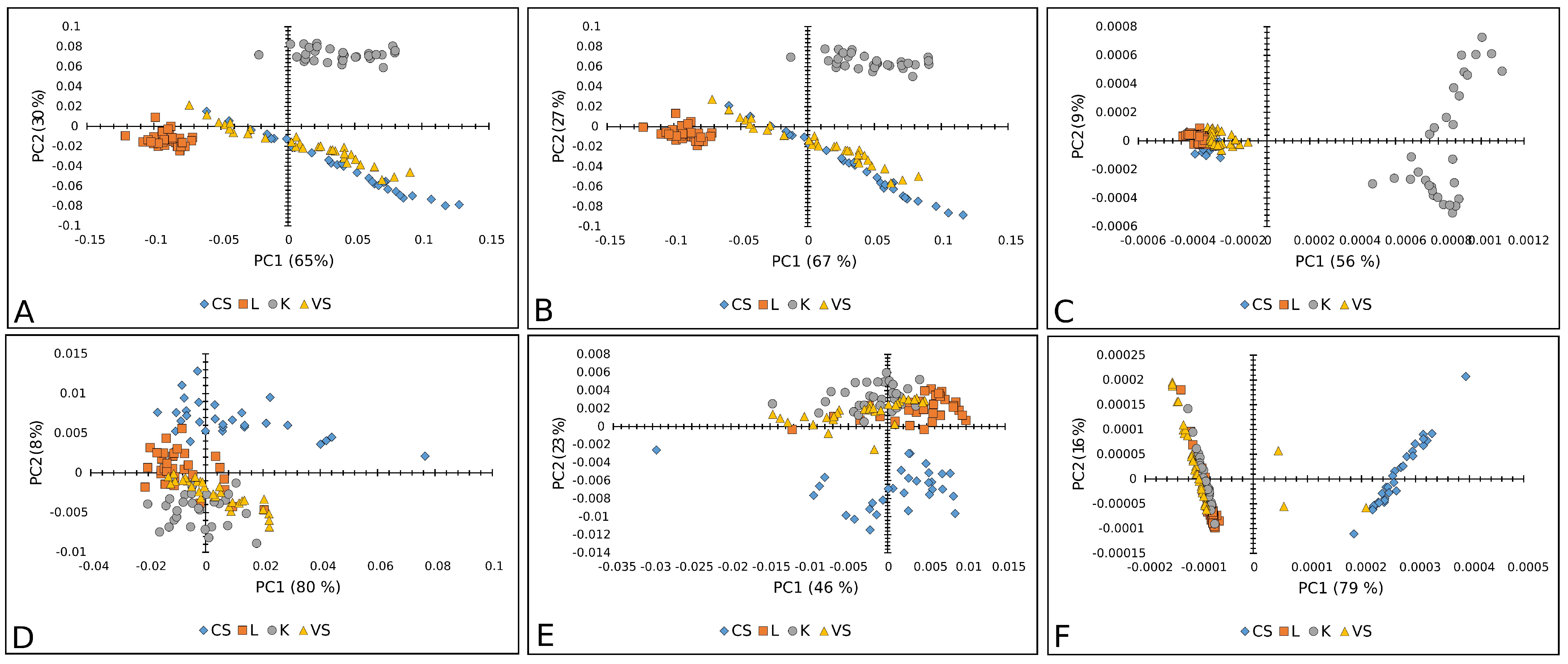
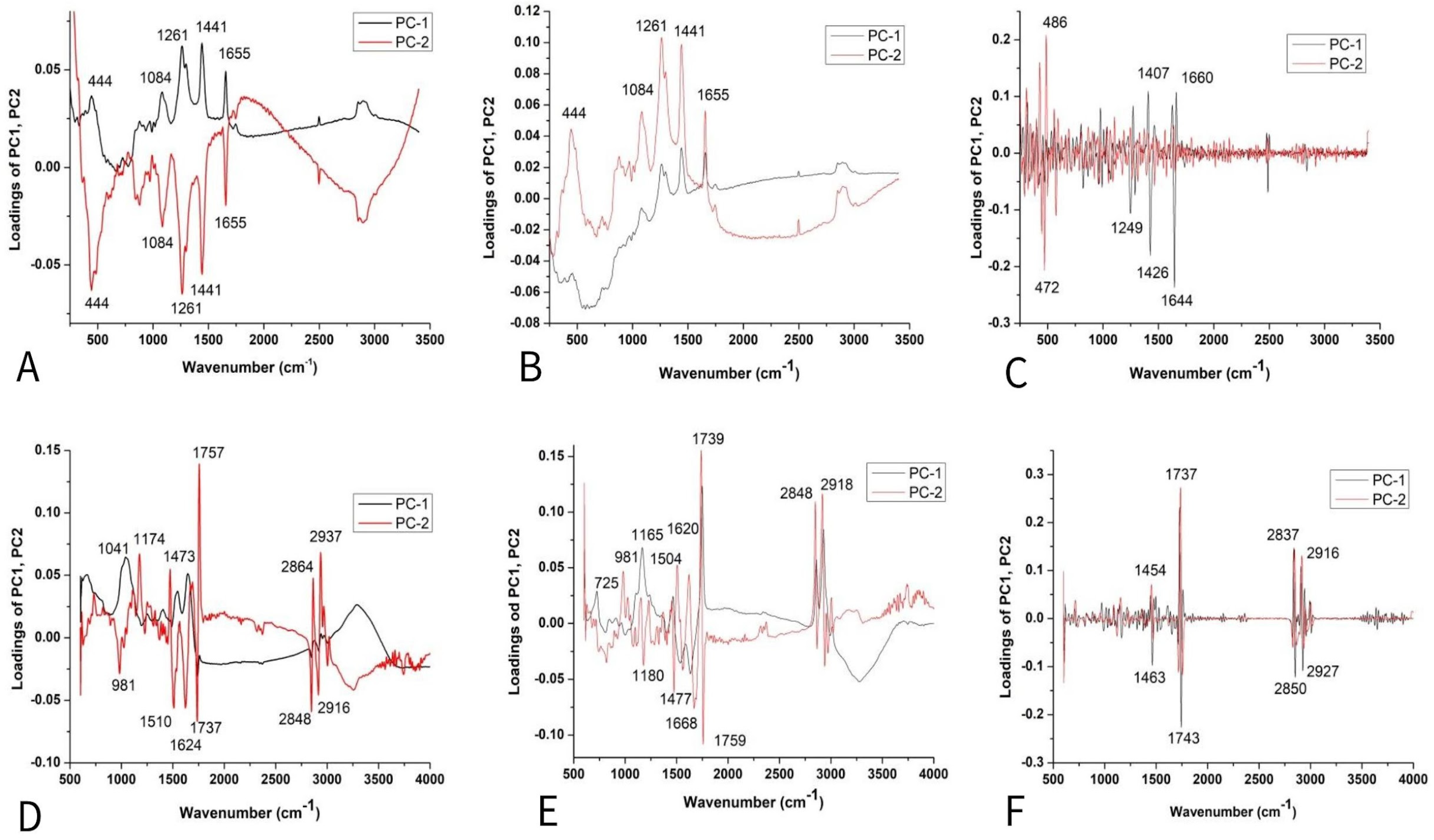

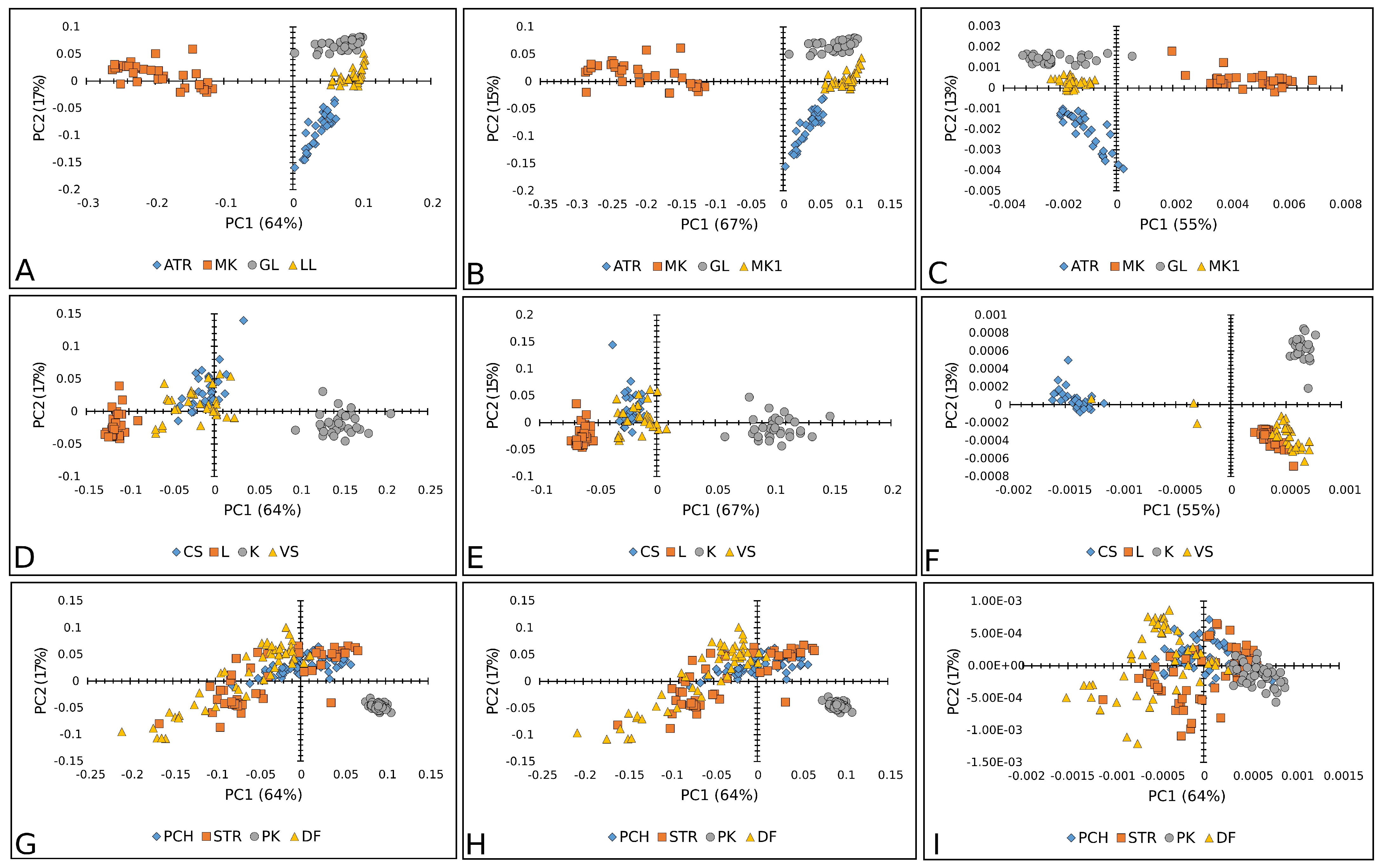


| Type of Spectroscopy | Type of Models | Type of Preprocessing | Varieties | Average (%) | |||
|---|---|---|---|---|---|---|---|
| Atrakcija | Majska Kraljica | Great Lakes | Ljubljanska Ledenka | ||||
| Test (%) | Test (%) | Test (%) | Test (%) | ||||
| Raman | PLS-DA | SM+BC+UN | 0.00 | 0.00 | 26.32 | 0.00 | 6.58 |
| SM+BC+UN+MSC | 0.00 | 0.00 | 0.00 | 0.00 | 0.00 | ||
| SM+BC+UN+2nd OD | 0.00 | 0.00 | 0.00 | 0.00 | 0.00 | ||
| PCA-QDA | SM+BC+UN | 100 | 100 | 94.74 | 100 | 98.69 | |
| SM+BC+UN+MSC | 100 | 100 | 100 | 100 | 100.00 | ||
| SM+BC+UN+2nd OD | 100 | 100 | 78.95 | 100 | 94.74 | ||
| SVM | SM+BC+UN | 100.00 | 100.00 | 100.00 | 100.00 | 100.00 | |
| SM+BC+UN+MSC | 95.00 | 95.00 | 95.00 | 95.00 | 95.00 | ||
| SM+BC+UN+2nd OD | 98.00 | 98.00 | 98.00 | 98.00 | 98.00 | ||
| FT-IR | PLS-DA | SM+BC+UN | 31.58 | 15.79 | 0.00 | 15.79 | 15.79 |
| SM+BC+UN+MSC | 63.18 | 15.79 | 0.00 | 0.00 | 19.74 | ||
| SM+BC+UN+2nd OD | 15.79 | 0.00 | 0.00 | 26.32 | 10.53 | ||
| PCA-QDA | SM+BC+UN | 10.53 | 63.18 | 100.00 | 94.74 | 67.11 | |
| SM+BC+UN+MSC | 84.21 | 94.74 | 100.00 | 100.00 | 94.74 | ||
| SM+BC+UN+2nd OD | 57.89 | 89.47 | 68.42 | 36.84 | 63.15 | ||
| SVM | SM+BC+UN | 97.50 | 100.00 | 100.00 | 100.00 | 99.37 | |
| SM+BC+UN+MSC | 97.50 | 90.00 | 90.00 | 90.00 | 91.87 | ||
| SM+BC+UN+2nd OD | 92.50 | 93.33 | 100.00 | 100.00 | 96.46 | ||
| Raman + FT-IR | SVM | SM+BC+UN | 100.00 | 0.00 | 0.00 | 0.00 | 25.00 |
| SM+BC+UN+MSC | 100.00 | 0.00 | 0.00 | 0.00 | 25.00 | ||
| SM+BC+UN+2nd OD | 100.00 | 100.00 | 100.00 | 100.00 | 100.00 | ||
| PCA-QDA | SM+BC+UN | 100.00 | 100.00 | 100.00 | 100.00 | 100.00 | |
| SM+BC+UN+MSC | 100.00 | 100.00 | 100.00 | 100.00 | 100.00 | ||
| SM+BC+UN+2nd OD | 100.00 | 0.00 | 0.00 | 0.00 | 25.00 | ||
| PCA-LDA | SM+BC+UN | 100.00 | 100.00 | 100.00 | 100.00 | 100.00 | |
| SM+BC+UN+MSC | 100.00 | 100.00 | 100.00 | 100.00 | 100.00 | ||
| SM+BC+UN+2nd OD | 100.00 | 0.00 | 0.00 | 0.00 | 25.00 | ||
| Type of Spectroscopy | Type of Models | Type of Preprocessing | Varieties | Average (%) | |||
|---|---|---|---|---|---|---|---|
| Palanacko Čudo | Strizanka | Palanačka Kapija | Delfina | ||||
| Test (%) | Test (%) | Test (%) | Test (%) | ||||
| Raman | PLS-DA | SM+BC+UN | 31.58 | 0.00 | 57.90 | 36.84 | 31.58 |
| SM+BC+UN+MSC | 26.32 | 0.00 | 57.90 | 36.84 | 30.26 | ||
| SM+BC+UN+2nd OD | 68.42 | 42.10 | 78.94 | 0.00 | 47.36 | ||
| PCA-QDA | SM+BC+UN | 89.47 | 0.00 | 5.26 | 47.37 | 35.52 | |
| SM+BC+UN+MSC | 89.47 | 42.10 | 5.26 | 47.37 | 60.50 | ||
| SM+BC+UN+2nd OD | 47.37 | 21.05 | 63.16 | 89.47 | 55.26 | ||
| SVM | SM+BC+UN | 83.00 | 83.33 | 100.00 | 100.00 | 92.71 | |
| SM+BC+UN+MSC | 87.50 | 80.00 | 100.00 | 100.00 | 91.87 | ||
| SM+BC+UN+2nd OD | 97.50 | 80.00 | 90.00 | 90.00 | 89.37 | ||
| FT-IR | PLS-DA | SM+BC+UN | 10.53 | 42.10 | 21.05 | 5.26 | 19.73 |
| SM+BC+UN+MSC | 16.13 | 0.00 | 0.00 | 42.12 | 14.56 | ||
| SM+BC+UN+2nd OD | 42.10 | 57.89 | 0.00 | 100.00 | 50.00 | ||
| PCA-QDA | SM+BC+UN | 73.68 | 21.05 | 78.95 | 31.58 | 51.31 | |
| SM+BC+UN+MSC | 42.10 | 36.82 | 12.90 | 100.00 | 47.95 | ||
| SM+BC+UN+2nd OD | 19.35 | 6.45 | 16.13 | 100.00 | 35.48 | ||
| SVM | SM+BC+UN | 82.50 | 86.67 | 85.00 | 85.00 | 84.79 | |
| SM+BC+UN+MSC | 85.00 | 85.00 | 90.00 | 90.00 | 87.50 | ||
| SM+BC+UN+2nd OD | 90.00 | 90.00 | 95.00 | 95.00 | 92.50 | ||
| Raman + FT-IR | SVM | SM+BC+UN | 79.00 | 79.00 | 100.00 | 79.00 | 84.25 |
| SM+BC+UN+MSC | 79.00 | 79.00 | 100.00 | 79.00 | 84.25 | ||
| SM+BC+UN+2nd OD | 95.00 | 79.00 | 100.00 | 79.00 | 88.25 | ||
| PCA-QDA | SM+BC+UN | 90.00 | 86.00 | 100.00 | 84.00 | 90.50 | |
| SM+BC+UN+MSC | 88.00 | 84.00 | 100.00 | 86.00 | 89.50 | ||
| SM+BC+UN+2nd OD | 100.00 | 88.00 | 98.00 | 94.00 | 95.00 | ||
| PCA-LDA | SM+BC+UN | 100.00 | 0.00 | 0.00 | 0.00 | 25.00 | |
| SM+BC+UN+MSC | 100.00 | 0.00 | 0.00 | 0.00 | 25.00 | ||
| SM+BC+UN+2nd OD | 100.00 | 0.00 | 0.00 | 0.00 | 25.00 | ||
| Type of Spectroscopy | Type of Models | Type of Preprocessing | Varieties | Average (%) | |||
|---|---|---|---|---|---|---|---|
| Crvena Stena | King F1 | Volovsko Srce | Lider F1 | ||||
| Test (%) | Test (%) | Test (%) | Test (%) | ||||
| Raman | PLS-DA | SM+BC+UN | 63.16 | 100.00 | 100.00 | 73.68 | 84.21 |
| SM+BC+UN+MSC | 52.63 | 100.00 | 100.00 | 47.37 | 75.00 | ||
| SM+BC+UN+2nd OD | 0.00 | 0.00 | 0.00 | 5.26 | 1.31 | ||
| PCA-QDA | SM+BC+UN | 89.47 | 94.74 | 100.00 | 89.47 | 93.42 | |
| SM+BC+UN+MSC | 100.00 | 100.00 | 100.00 | 100.00 | 100.00 | ||
| SM+BC+UN+2nd OD | 89.47 | 89.47 | 100.00 | 84.21 | 90.79 | ||
| SVM | SM+BC+UN | 92.50 | 100.00 | 85.00 | 100.00 | 94.38 | |
| SM+BC+UN+MSC | 85.00 | 100.00 | 100.00 | 100.00 | 96.25 | ||
| SM+BC+UN+2nd OD | 82.50 | 100.00 | 100.00 | 100.00 | 95.62 | ||
| FT-IR | PLS-DA | SM+BC+UN | 0.00 | 15.79 | 0.00 | 5.26 | 5.26 |
| SM+BC+UN+MSC | 100.00 | 63.16 | 0.00 | 26.32 | 47.37 | ||
| SM+BC+UN+2nd OD | 89.47 | 36.84 | 52.63 | 52.63 | 57.89 | ||
| PCA-QDA | SM+BC+UN | 89.47 | 42.10 | 47.37 | 100.00 | 59.65 | |
| SM+BC+UN+MSC | 100.00 | 84.21 | 42.10 | 89.47 | 78.94 | ||
| SM+BC+UN+2nd OD | 89.47 | 73.68 | 47.37 | 89.47 | 75.00 | ||
| SVM | SM+BC+UN | 90.00 | 100.00 | 100.00 | 100.00 | 97.50 | |
| SM+BC+UN+MSC | 80.00 | 100.00 | 95.00 | 95.00 | 92.50 | ||
| SM+BC+UN+2nd OD | 77.50 | 100.00 | 95.00 | 95.00 | 91.87 | ||
| Raman + FT-IR | SVM | SM+BC+UN | 100.00 | 100.00 | 100.00 | 100.00 | 100.00 |
| SM+BC+UN+MSC | 100.00 | 100.00 | 100.00 | 100.00 | 100.00 | ||
| SM+BC+UN+2nd OD | 100.00 | 88.89 | 100.00 | 86.11 | 93.55 | ||
| PCA-QDA | SM+BC+UN | 100.00 | 100.00 | 100.00 | 97.22 | 99.19 | |
| SM+BC+UN+MSC | 100.00 | 100.00 | 100.00 | 97.22 | 99.19 | ||
| SM+BC+UN+2nd OD | 100.00 | 100.00 | 100.00 | 91.67 | 97.92 | ||
| PCA-LDA | SM+BC+UN | 100.00 | 0.00 | 0.00 | 0.00 | 25.00 | |
| SM+BC+UN+MSC | 100.00 | 0.00 | 0.00 | 0.00 | 25.00 | ||
| SM+BC+UN+2nd OD | 100.00 | 0.00 | 0.00 | 0.00 | 25.00 | ||
Disclaimer/Publisher’s Note: The statements, opinions and data contained in all publications are solely those of the individual author(s) and contributor(s) and not of MDPI and/or the editor(s). MDPI and/or the editor(s) disclaim responsibility for any injury to people or property resulting from any ideas, methods, instructions or products referred to in the content. |
© 2025 by the authors. Licensee MDPI, Basel, Switzerland. This article is an open access article distributed under the terms and conditions of the Creative Commons Attribution (CC BY) license (https://creativecommons.org/licenses/by/4.0/).
Share and Cite
Kolašinac, S.M.; Mladenović, M.; Pećinar, I.; Šoštarić, I.; Nedović, V.; Miladinović, V.; Dajić Stevanović, Z.P. Raman and FT-IR Spectroscopy Coupled with Machine Learning for the Discrimination of Different Vegetable Crop Seed Varieties. Plants 2025, 14, 1304. https://doi.org/10.3390/plants14091304
Kolašinac SM, Mladenović M, Pećinar I, Šoštarić I, Nedović V, Miladinović V, Dajić Stevanović ZP. Raman and FT-IR Spectroscopy Coupled with Machine Learning for the Discrimination of Different Vegetable Crop Seed Varieties. Plants. 2025; 14(9):1304. https://doi.org/10.3390/plants14091304
Chicago/Turabian StyleKolašinac, Stefan M., Marko Mladenović, Ilinka Pećinar, Ivan Šoštarić, Viktor Nedović, Vladimir Miladinović, and Zora P. Dajić Stevanović. 2025. "Raman and FT-IR Spectroscopy Coupled with Machine Learning for the Discrimination of Different Vegetable Crop Seed Varieties" Plants 14, no. 9: 1304. https://doi.org/10.3390/plants14091304
APA StyleKolašinac, S. M., Mladenović, M., Pećinar, I., Šoštarić, I., Nedović, V., Miladinović, V., & Dajić Stevanović, Z. P. (2025). Raman and FT-IR Spectroscopy Coupled with Machine Learning for the Discrimination of Different Vegetable Crop Seed Varieties. Plants, 14(9), 1304. https://doi.org/10.3390/plants14091304






